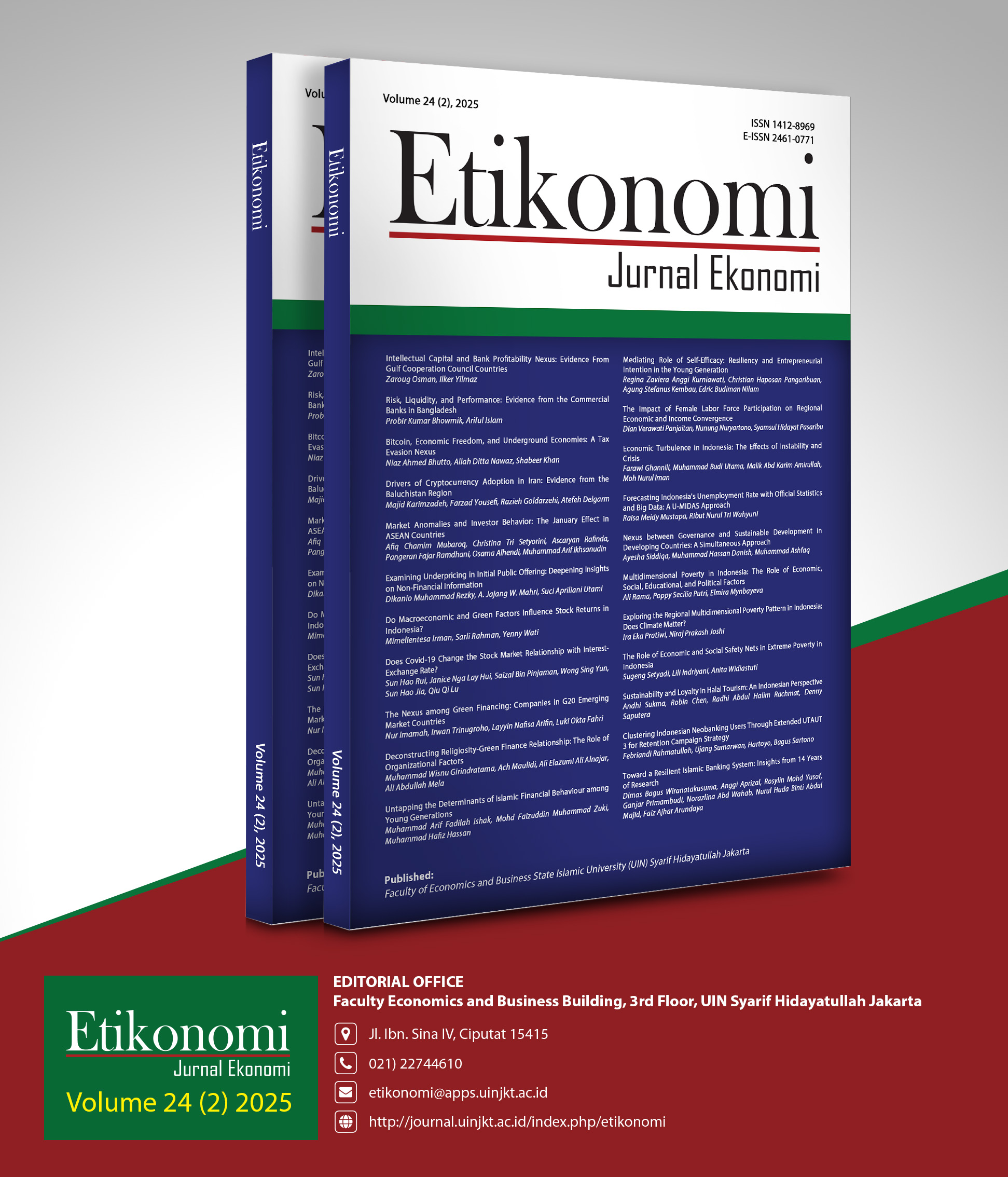Drivers of Cryptocurrency Adoption in Iran: Evidence from the Baluchistan Region
DOI:
https://doi.org/10.15408/etk.v24i2.42529Keywords:
acceptance, cryptocurrency, economic instability, social influenceAbstract
Research Originality: This study explores the key factors influencing the acceptance of cryptocurrencies in Iran, focusing on the under-researched Baluchistan region. In contrast to previous studies focusing on developed or technologically advanced economies, this research explores a socioeconomically disadvantaged region experiencing economic instability and restricted access to formal financial services.
Research Objectives: The main goal of the study is to identify and analyze the key factors influencing cryptocurrency acceptance in this region.
Research Methods: Using data from 200 active cryptocurrency users, we employed exploratory factor analysis followed by multiple regression analysis to identify and test predictive factors.
Empirical Results: The findings reveal six primary drivers: financial constraints, national economic volatility, personality traits, social influences, managerial factors, and trust. Among these, income-related motivations and macroeconomic instability emerged as the strongest predictors of adoption.
Implications: The study contributes to the literature by contextualizing cryptocurrency behavior within a developing country’s marginalized setting and provides insights for policymakers to enhance financial inclusion. It also highlights the need for regulatory clarity and user education to support safe and effective participation in digital finance.
JEL Classification: G1, G4, G10, G41
Downloads
References
Abu-Shanab, E. (2013). Income Divide: a Determinant of Technology Acceptance. International Arab Journal of E-Technology, 3(2), 121-127.
Alzahrani, S., & Daim, T.U. (2019). Analysis of The Cryptocurrency Adoption Decision: Literature Review. Proceeding of 2019 Portland International Conference on Management of Engineering and Technology (PICMET), 1-11.
Apostolaki, M., Zohar, A., & Vanbever, L. (2017). Hijacking Bitcoin: Large-Scale Network Attacks on Cryptocurrencies. Proceeding of 2017 IEEE Symposium on Security and Privacy.
Baur, D. G., Hong, K., & Lee, A. D. (2018). Bitcoin: Medium of Exchange or Speculative Assets?. Journal of International Financial Markets, Institutions and Money, 54, 177–189.
Calderón, O. P. (2018). Herding Behavior in Cryptocurrency Markets. Working Paper Universitat Autonoma de Barcelona.
Carrick, J. (2016). Bitcoin as a Complement to Emerging Market Currencies. Emerging Markets Finance and Trade, 52(10), 2321–2334. https://doi.org/10.1080/1540496X.2016. 1193002.
Chang, S. E., Liu, A. Y., & Shen, W. C. (2017). User Trust in Social Networking Services: A Comparison of Facebook and LinkedIn. Computers in Human Behavior, 69, 207-217. https://doi.org/10.1016/j.chb.2016.12.013.
Chen, X., Miraz, M.H., Gazi, M.A.I., Rahaman, M.A., Habib, M.M., & Hossain, A.I. (2022). Factors Affecting Cryptocurrency Adoption in Digital Business Transactions: The Mediating Role of Customer Satisfaction. Technology in Society, 70, 102059. https://doi.org/10.1016/j.techsoc.2022.102059.
Cohen, J. (1988). Statistical Power Analysis for The Behavioral Sciences (2nd ed.). New Jersey: Hillsdale.
Conti, M., Kumar, E. S., Lal, C., & Ruj, S. (2018). A Survey on Security and Privacy Issues of Bitcoin. IEEE Communications Surveys & Tutorials, 20(4), 3416–3452.
Dhagarra, D., Goswami, M., & Kumar, G. (2020). Impact of Trust and Privacy Concerns on Technology Acceptance in Healthcare: An Indian Perspective. International Journal of Medical Informatics, 141, 104164. https://doi.org/10.1016/j.ijmedinf.2020.104164.
Folkinshteyn, D., & Lennon, M. (2016). Braving Bitcoin: A Technology Acceptance Model (TAM) Analysis. Journal of Information Technology Case and Application Research, 18(4), 220–249. https://doi.org/10.1080/15228053.2016.1275242.
Gil-Cordero, E., Cabrera-Sánchez, J. P., & Arrás-Cortés, M. J. (2020). Cryptocurrencies as a Financial Tool: Acceptance Factors. Mathematics, 8(11), 1974. https://doi.org/10.3390/math8111974.
Hasan, Z., Syuhada, B., & Indira, N. (2023). Islamic Legal View on Buying and Selling Bitcoin. Journal of Islamic Studies and Humanities, 8(1), 15-34. https ://doi. org/ 10.21580 /jish. v8i1.14956.
Hayashi, F., & Routh, A. (2025). Financial Literacy, Risk Tolerance, and Cryptocurrency Ownership in the United States. Journal of Behavioral and Experimental Finance, 46, 101060. https://doi.org/10.1016/j.jbef.2025.101060.
Henson, R. K., & Roberts, J. K. (2006). Use of Exploratory Factor Analysis in Published Research: Common Errors and Some Comment on Improved Practice. Educational and Psychological Measurement, 66(3), 393-416.
Jalan, A., Matkovskyy, R., Urquhart, A., & Yarovaya, L. (2023). The Role of Interpersonal Trust in Cryptocurrency Adoption. Journal of International Financial Markets, Institutions and Money, 83, 101715. https://doi.org/10.1016/j.intfin.2022.101715.
Khani, M., Hoveidi, H., Yavari, A. R., & Khani, M. (2020). Using Factor Analysis in Compilation, Evaluation and Identification of The Most Effective Criteria of Indigenous Knowledge in The Management and Planning of Water Resources in Arid and Semi-Arid Regions of Iran (Yazd Province). Indigenous Knowledge, 7(14), 105-152. https://doi.org/10.22054/qjik.2021.60055.1262.
Krombholz, K., Judmayer, A., Gusenbauer, M., & Weippl, E. (2016). The Other Side of The Coin: User Experiences with Bitcoin Security and Privacy. Proceeding of the International Conference on Financial Cryptography and Data Security.
Kumar, A. S., & Anandarao, S. (2019). Volatility Spillover in Crypto-Currency Markets: Some Evidences from GARCH and Wavelet Analysis. Physica A: Statistical Mechanics and its Applications, 524, 448-458.
Liu, Y., Yang, M., Pelster, M., & Tan, Y. (2024). The Interplay of Opinions and Trading Behavior: Understanding Cryptocurrency Adoption Dynamics. Proceeding of the ICIS 2024.
Luo, J., Zhang, S., & Zhang, C. (2025). Drivers of Investment Intentions Across Diverse Cryptocurrency Categories. Finance Research Letters, 77, 107024. https://doi.org/10.1016/j.frl.2025.107024.
Madanchian, M., Mohamed, N., & Taherdoost, H. (2025). Exploring Cryptocurrency Acceptance Patterns: An In-Depth Review of Influencing Factors from Adoption to Adaption for Human Resource Management. Procedia Computer Science, 258, 3072–3083. https://doi.org/10.1016/j.procs.2025.04.565.
Murakami, D., & Viswanath-Natraj, G. (2025). Cryptocurrencies in Emerging Markets: A Stablecoin Solution? Journal of International Money and Finance, 156, 103344. https://doi.org/10.1016/j.jimonfin.2025.103344.
Nadeem, M. A., Liu, Z., Pitafi, A. H., Younis, A., & Xu, Y. (2021). Investigating The Adoption Factors of Cryptocurrencies—a Case of Bitcoin: Empirical Evidence from China. Sage open, 11(1), 1-15. https://doi.org/10.1177/2158244021998704.
Özbek, V., Alnıaçık, Ü., Koç, F., Akkılıç, M. E., & Kaş, E. (2014). The Impact of Personality on Technology Acceptance: A Study on Smart Phone Users. Procedia - Social and Behavioral Sciences, 150, 541-551. https://doi.org/10.1016/j.sbspro.2014.09.073.
Philippas, D., Rjiba, H., Guesmi, K., & Goutte, S. (2019). Media Attention and Bitcoin Prices. Finance Research Letters, 30, 37–43. https://doi.org/10.1016/j.frl.2019.03.031.
Rahayu, S. K. (2022). Implementation of Blockchain in Minimizing Tax Avoidance of Cryptocurrency Transaction in Indonesia. International Journal of Research and Applied Technology, 2(1), 30-43.
Setiawan, P., & Widanta, A. (2021). The Effect of Trust on Travel Agent Online Use: Application of The Technology Acceptance Model. International Journal of Data and Network Science, 5(3), 173-182.
Shahab, M. H., Wasiq, M. R., & Potapova, M. A. (2022). Cryptocurrencies: A Critical Analysis from the Perspective of Islamic Law. Change Management, 22(2), 343-356.
Shahzad, F., Xiu, G., Wang, J., & Shahbaz, M. (2018). An Empirical Investigation on The Adoption of Cryptocurrencies Among The People of Mainland China. Technology in Society, 55(1), 33–40. https://doi.org/10.1016/j.techsoc.2018.05.006.
Shahzad, M. F., Xu, S., Lim, W. M., Hasnain, M. F., & Nusrat, Sh. (2024). Cryptocurrency Awareness, Acceptance, and Adoption: The Role of Trust as A Cornerstone. Humanities and Social Sciences Communications, 11(4), 1-14. https://doi.org/10.1057/s41599-023-02528-7.
Sun, W., Dedahanov, A. T., Shin, H. Y., & Li, W. P. (2021). Factors Affecting Institutional Investors to Add Cryptocurrency to Asset Portfolios. North American Journal of Economics and Finance, 58, 101499. https://doi.org/10.1016/j.najef.2021.101499.
Svendsen, G. B., Johnsen, J. A. K., Almås-Sørensen, L., & Vittersø, J. (2013). Personality and Technology Acceptance: The Influence of Personality Factors on The Core Constructs of the Technology Acceptance Model. Behaviour & Information Technology, 32(4), 323–334. https://doi.org/10.1080/0144929X.2011.553740.
Tambotoh, J. J. C., Manuputty, A. D., & Banunaek, F. E. (2015). Socio-Economics Factors and Information Technology Adoption in Rural Area. Procedia Computer Science, 72, 178-185. https://doi.org/10.1016/j.procs.2015.12.119.
Verkasalo, H., López-Nicolás, C., Castillo, F., & Bouwman, H. (2010). Analysis of Users and Non-Users of Smartphone Applications. Telematics and Informatics, 27(3), 242–255. https://doi.org/10.1016/j.tele.2009.11.001.
Wang, S. W., Ngamsiriudom, W., & Hsieh, C. H. (2015). Trust Disposition, Trust Antecedents, Trust, and Behavioral Intention. The Service Industries Journal, 35(10), 555-572. https://doi.org/10.1080/02642069.2015.1047827.
Wei, M. F., Luh, Y. H., Huang, Y. H., & Chang, Y. C. (2021). Young Generation's Mobile Payment Adoption Behavior: Analysis Based on An Extended UTAUT Model. Journal of Theoretical and Applied Electronic Commerce Research, 16(4), 618-637. https://doi.org/10.3390/jtaer16040037.
Xu, T., Grubbs, J. B., & Kraus, S. W. (2025). Problem Gambling in The Crypto Era: A Study of Gambling Motivations and Cognitive Distortions Amongst Cryptocurrency Traders. Public Health, 244, 105741. https://doi.org/10.1016/j.puhe.2025.105741.
Zebardast, E. (2017). Exploratory Factor Analysis in Urban and Regional Planning. Journal of Fine Arts: Architecture & Urban Planning, 22(2), 5-18. https://doi.org/10.22059/jfaup.2017.240054.671801.
Zerilli, J., Bhatt, U., & Weller, A. (2022). How Transparency Modulates Trust in Artificial Intelligence. Patterns, 3(4), 100455. https://doi.org/10.1016/j.patter.2022.100455.
Downloads
Published
Issue
Section
License
Copyright (c) 2025 Majid Karimzadeh, Farzad Yousefi, Razieh Goldarzehi, Atefeh Delgarm

This work is licensed under a Creative Commons Attribution-ShareAlike 4.0 International License.










